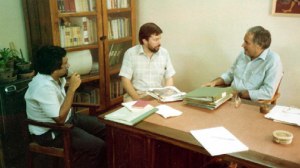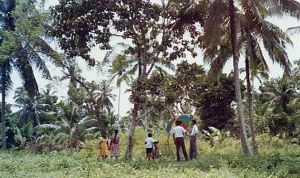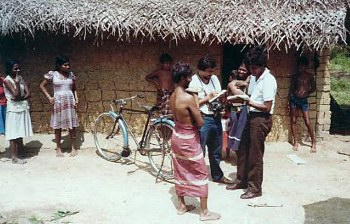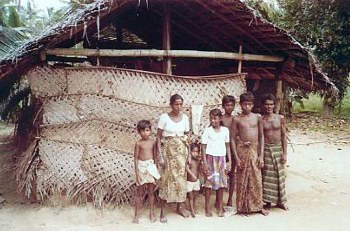Sri Lanka 1987
World Vision's business is development aid. I learned much about it on my journeys. In Sri Lanka I began to see more of the complexity of the development process, and the need to work, plan and implement holistically, aware of that full complexity. Questions such as 'Whose project is it anyway -- World Vision's or the local community's?' started to have meaning for me. My awareness of cultural differences, especially in attitudes towards the poor, increased. Along the way I recognised, through the observation of international adoption, that good ideas sometimes have bad side-effects.
Holes in Projects Lead to Holistic Thinking
For many years, everyone at World Vision thought our project work in Sri Lanka was the model of good development. It was based on revolving loan programs. Small amounts of capital were given to a community which then made loans to its people for agricultural or income-producing schemes, with the idea that the people would pay back the loans from the product of their labour. The repaid funds went back into the community loan bank.
There was only one problem with this excellent approach: it was hard to explain and therefore hard to sell to supporters. (Of course, this might have said more about the creativity of our marketing strategies than about the creativity of our development work!)
Then Peter Berry became our director in Sri Lanka. He took a good, hard look at this model program and decided it had deficiences. He described it as a 'good but narrow ministry'.
'The question we asked was How has the community's life improved?', he explained 'Certainly economic conditions had improved, but hope for the future and steps towards the kingdom...?' He paused, to imply he was thinking out the answer. 'Nothing', he concluded.
Revolving loan programs could be a component, but they were not themselves the ministry. Peter realised that a measurable, holistic community development approach was needed.
Useful American Know-How
Peter had made other innovations as well. He felt it was essential to help the people in the project communities, as well as his own staff, understand who sponsors and donors were. He recognised the dangers of uninformed support -- a mythology of donors is created. So with the advantage of an American upbringing he became the surrogate sponsor. When he visited staff in projects, he pretended to be the sponsor. He asked questions, the dumber the better. The staff learned about sponsors and began to see their project through the sponsor's eyes.
Peter had also forged partnership links with Rural Development Societies, linking World Vision closely with the government. This was positive, but it had its downsides too. Politicians wanted to influence us to work in certain areas and on politically attractive activities. But we were not in the government's business. Often they needed to be sternly reminded of this.
I liked Peter. He was quirky and individualistic, but he was really making things happen. That appealed to my Western ways even if I was slow to recognise why. He had clear vision. He was building people. His pushiness was tempered with obvious sincerity and love for village people. He laughed a lot, which is always a good sign.
 We sat in Peter's office in an upstairs room of an old suburban house. Colombo life went on around. The noises and heat of the morning enveloped us as we listened to his introductory lecture. When the heat began to build, Peter moved around his desk to a small refrigerator. It was full of Coke.
We sat in Peter's office in an upstairs room of an old suburban house. Colombo life went on around. The noises and heat of the morning enveloped us as we listened to his introductory lecture. When the heat began to build, Peter moved around his desk to a small refrigerator. It was full of Coke.

'A small but essential vestige of my culture', he said, grinning. As the Coke refreshed us the lecture continued.
Move 'Em Out
Peter was pioneering an approach to project workers that was later to become more commonplace. These workers go under vanous titles in different countries. In the Philippines they are called community development workers (inevitably abbreviated to CDW). Sometimes they are called facilitators, sometimes project managers.
Peter's innovation was to move project workers out of the office. Instead of being responsible for many projects, Peter's plan was to give each one only a few, then to ask them to go and live in, or near, the projects. Only by entering the community personally could project workers really understand a community. And only with this understanding could they be agents for positive change.
'Everyone on staff visits projects', said Peter. 'I mean everyone.' I found myself thinking it would be good if everyone at World Vision Australia visited sponsors. 'Project workers will know every child and every family in their projects. They will especially know if children are sick.' Peter's idea had also removed the need for area supervisors. He had saved a layer of management -- and cost.
'We don't own projects in Sri Lanka', Peter continued. (I hoped we did not 'own' them anywhere.) 'We are friends to projects. The communities must own them themselves. And they do.'
Evangelism or Social Action?
One area that concerned Peter was evangelism. 'There is no real evangelism component in our projects', he explained. An evangelist was paid to make fortnightly visits, distributing tracts and preaching. This was very unreliable, and not measured.

I saw his point but I didn't like his phrase, and said so. We talked about it later. Evangelism is not a 'component'; it is part of everything that happens. You cannot have a 'management component. Nor can you have a 'Sri Lankan component'. Nor can you have a 'development component'. These are not activities, methodologies or techniques. They are core values and fundamental philosophies which underpin and flavour every activity, method and technology. You can emphasise the evangelism aspect or the development aspect, but talking about an evangelism 'component' reduces the work of sharing the Good News of the kingdom to a mere method. Of course, proclaiming the Good News by preaching and teaching is an important evangelistic activity. But so is development work done by Christians.
Tea and Science Fiction
From my boyhood, two images of Sri Lanka had prepared me for this visit. One was tea. This was where tea came from, or so I thought. And not just tea, but Ceylon tea.
The other image was Arthur C. Clarke. I had read all of his science fiction novels and many of his short stories. The idea that a science fiction writer would base himself in Colombo attacked my limited stereotypes of the Third World. It helped me realise that the Third World must be full of great variety -- poverty and riches, technological sophistication and primitive mechanics.
An Economy Heading South
The present-day truth about Sri Lanka showed that the Arthur C. Clarke image was true of only a small, and depressingly decreasing, minority.
Universities were closed, in a country which for years boasted the best education in Asia. Medical students had not had exams for two years.
Tourism was down. The Hilton Hotel was at thirty per cent occupancy, and this was one of the highest. It was also the most expensive at US$35 per day. Such prices seemed incredible bargains to us; the cheapest decent hotel in Melbourne was twice this price. But the hotel we stayed in, Mount Royal Beach Hotel, charged a mere US$7 per day. It was only ten per cent full.
Up in the north and north-east the fighting was disruptive and frightening. We didn't know how the projects were going up there. No project visits had been made in six months, but recently someone had come to Colombo from that area and that helped us to stay in touch.
Unemployment continued to rise. Terrorist action by Singhalese against Singhalese six to nine months before had seemed to be directed against the government's action in not holding elections. Instead they held a referendum asking 'Do you want the present government to continue or not?' The people, faced with Hobson's choice, voted Yes.
Baby For Sale
Staying at our hotel were Scandinavian couples with Sri Lankan children who spoke what sounded like Swedish. They had already adopted the children who were with them, and now they were coming back for more. This sounded lovely to me.
The problem was that 'baby farms' had become established. Women had babies specifically to supply the demand from childless European couples. Middle men charged 10,000 rupees (A$500) for the service. This sounded like a bargain. But the mothers got hardly anything, and such activities exploited them for commercial gain.
I admit I found this question a tough one. One could not blame the childless Europeans. They were good people. I watched them play with their brown kids by the swimming pool. They were very loving towards one other. These children would probably never have been born except for a system that commercialised pregnancy.
A Project With A Living Fence
 Soon it was time to go and visit a project. We piled into a van in the heat and sweated our way along. Peter's plan was for us to walk through the village for an hour, then share lunch with some local government officials.
Soon it was time to go and visit a project. We piled into a van in the heat and sweated our way along. Peter's plan was for us to walk through the village for an hour, then share lunch with some local government officials.
 We sat in Peter's office in an upstairs room of an old suburban house. Colombo life went on around. The noises and heat of the morning enveloped us as we listened to his introductory lecture. When the heat began to build, Peter moved around his desk to a small refrigerator. It was full of Coke.
We sat in Peter's office in an upstairs room of an old suburban house. Colombo life went on around. The noises and heat of the morning enveloped us as we listened to his introductory lecture. When the heat began to build, Peter moved around his desk to a small refrigerator. It was full of Coke. Soon it was time to go and visit a project. We piled into a van in the heat and sweated our way along. Peter's plan was for us to walk through the village for an hour, then share lunch with some local government officials.
Soon it was time to go and visit a project. We piled into a van in the heat and sweated our way along. Peter's plan was for us to walk through the village for an hour, then share lunch with some local government officials. Our small party walked into an area behind more living fencing. The ground was swept clean. A single-roomed hut stood in the centre of the compound. There we met Mahini, who at twenty-six was the mother of four children. She shared her hut with six others, including her husband and his mother.
Our small party walked into an area behind more living fencing. The ground was swept clean. A single-roomed hut stood in the centre of the compound. There we met Mahini, who at twenty-six was the mother of four children. She shared her hut with six others, including her husband and his mother. 'They don't mind', said Dias with surprise. 'Everyone knows. After all, it's karma. It's not their fault they are poor.
'They don't mind', said Dias with surprise. 'Everyone knows. After all, it's karma. It's not their fault they are poor.